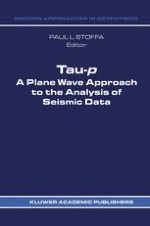1989 | OriginalPaper | Buchkapitel
Inversion of Common Mid Point Seismic Data
verfasst von : Anton Ziolkowski, Jacob T. Fokkema, Klaas-jan Koster, Arjen Confurius, Ruud Van Boom
Erschienen in: Tau-p: a plane wave approach to the analysis of seismic data
Verlag: Springer Netherlands
Enthalten in: Professional Book Archive
Aktivieren Sie unsere intelligente Suche, um passende Fachinhalte oder Patente zu finden.
Wählen Sie Textabschnitte aus um mit Künstlicher Intelligenz passenden Patente zu finden. powered by
Markieren Sie Textabschnitte, um KI-gestützt weitere passende Inhalte zu finden. powered by
Inversion of seismic reflection data is normally done by iterative forward model-ling. There are three problems with this approach. First, the choice of initial model and the number of parameters required to specify it are usually uncon-strained. Secondly, because of the lack of constraints, it becomes extremely difficult to find the optimum model. The optimum model is usually found by minimizing the error between the wavefield calculated from the model and the measured wavefield. The minimum reached is usually a local, rather than a global, minimum. Thirdly, the data are used only to calculate the error.In our view, the choice of initial model should be inherently constrained by the data. We have developed a scheme that works in either the time domain or the frequency domain, for determining the acoustic parameters of the layered earth by directly inverting the CMP data, assuming that a CMP gather is equivalent to a shot gather over a horizontally-layered acoustic earth. The scheme is recursive, and is essentially the inverse of the forward reflectivity method. The recovered earth model is constructed from the top layer downwards, by stripping off the layers one by one. All interbed peg-leg multiples are included in the scheme. The result is an equivalent plane layered earth model for each CMP gather.To apply the scheme in practice it is crucial to have accurate measurements of the source wavefield. If the source is not a point, the wavefield must be collapsed to that of a point source before transform of the data to plane wave components in the τ-p domain. The source wavelet and the influence of the free surface must be removed before applying the layer-stripping algorithm. The algorithm is un-stable in the presence of noise. Stabilization is achieved by limiting the magnitude of the recovered reflection coefficients, and by limiting the number of peg-leg multiples that are removed with each layer.We show that the scheme works on synthetic data but, in the presence of noise, the recovered impedance profile is in error at low frequencies. This low frequency information can be obtained from the travel-time information using normal velocity analysis and an empirical velocity-density relation. Since this trend information is essentially independent of the layer-stripping results, it is probably better to use the frequency domain method, in which the trend information does not influence the layer-stripping scheme.We have also applied our scheme to tank data and to a shot record from a data set shot in the North Sea. In both cases, the inversion works well and is stable. Addition of the trend information to recover the impedance must be done with great care. The recovery of the reflection coefficient series is robust and inde-pendent of the trend information. Comparison of the inverted North Sea data with a well-log is quite good. Errors in the inversion are caused both by lack of precision in the specification of the acquisition parameters, especially of the source wavefield, and in the removal of the free surface, which is done by predictive deconvolution. There are also errors in the log.
